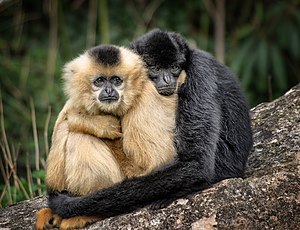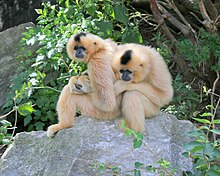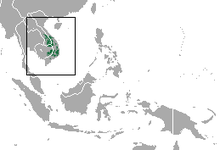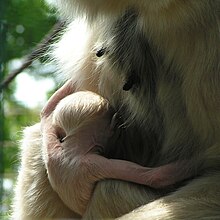Southern yellow-cheeked crested gibbon
| Southern yellow-cheeked crested gibbon | ||||||||||||
|---|---|---|---|---|---|---|---|---|---|---|---|---|

Males and females of the southern yellow-cheeked crested gibbon |
||||||||||||
| Systematics | ||||||||||||
|
||||||||||||
| Scientific name | ||||||||||||
| Nomascus gabriellae | ||||||||||||
| ( Thomas , 1909) |
The Southern Yellow-cheeked Gibbon ( Nomascus gabriellae ) is a primate of the family of gibbons (Hylobatidae).
features
Southern yellow-cheeked crested gibbons reach a head body length of up to 49 cm (males) or 47 cm (females) and a weight of up to 5 kg. Like all species of the genus Nomascus , this species also has a pronounced sexual dimorphism. Males are black, females yellow-brown. The yellowish to orange-colored cheeks in the males and the black vertex in the females are characteristic. Young animals, regardless of gender, are initially yellow-brown in color and develop a black coat color after around six months. Only with the onset of sexual maturity do the female animals change their coat color again to the typical female brown color.
distribution and habitat
Southern yellow-cheeked crested gibbons have the southernmost distribution area of all crested gibbons. It includes the extreme south of Laos , southern Vietnam and eastern Cambodia . The Mekong forms the western and southern borders of their occurrence. Wet evergreen and semi-evergreen forests in the lowlands and mixed bamboo and deciduous forests represent the habitat.
Way of life
Southern yellow-cheeked crested gibbons are diurnal and almost exclusively tree-dwelling, where they move either by swinging or by walking on the branches on their hind legs with arms raised. The activity begins just before dawn and with loud calls, mostly 30 minutes after sunrise. The duet chants, which serve to mark the area and establish contact with the other family members, last an average of 12 minutes. The animals live in monogamous groups consisting of a couple and their young, i.e. 3 to 6 animals. Young females tend to spread to other territories near their parents, while males migrate significantly further. A district can be up to 60 hectares in size.
The menu of the southern yellow-cheeked gibbon is dominated by figs (38%) and other fruits (43%). This is supplemented by leaves (9%) and flowers (8%). The high consumption of fruits is in contrast to the more northern species of the genus, which primarily eat leaves.
Reproduction
After a gestation period of around seven months, the female gives birth to a single young. Only with the onset of sexual maturity (presumably at 6 to 8 years of age) do the female animals change their coat color again to the typical female brown color.
Life expectancy in captivity is up to 50 years. No reliable information can yet be given about the lifespan in the wild.
Hybrids between the southern yellow-cheeked gibbon and the northern white-cheeked gibbon are known. It is even believed that the southern white-cheeked crested gibbon is not a species in its own right, but the natural hybrid between the above species.
threat
The southern yellow-cheeked crested gibbon is classified by the IUCN as "endangered" (highly endangered). It is protected in Vietnam and Cambodia and occurs in 15 nature reserves. The most significant population in Cambodia is in the Seima Protection Forest with 432 to 972 groups. In Vietnam, the 149 groups in Cat Tien National Park and 124 groups in Bu Gia Map National Park represent important and large populations. Hunting is the greatest threat to the species. The animals are caught for zoos and private collections in southern Vietnam. There is even a trade in young animals whose mothers have been shot. The loss of suitable habitats is also significant. The forests are mostly cut down for the timber industry and are then used for agricultural purposes.
Individual evidence
- ^ Roger Konrad, Thomas Geissmann: Vocal diversity and taxonomy of Nomascus in Cambodia. In: International Journal of Primatology 27, No. 3, 2006, pp. 713-745.
- ↑ International Zoo Yearbook. 1983, p. 317.
- ^ Russell A. Mittermeier, Anthony B. Rylands, Don E. Wilson: Handbook of the Mammals of the World. Volume 3: Primates. 2013, pp. 790–791.
- ↑ Thomas Geissmann: Status reassessment of the gibbons: results of the Asian primate red list workshop 2006. ( Memento of the original from March 28, 2012 in the Internet Archive ) Info: The archive link was inserted automatically and has not yet been checked. Please check the original and archive link according to the instructions and then remove this notice. (PDF) In: Gibbon Journal 3, 2007, pp. 5–15.
- ↑ Benjamin Miles Rawson, Tom Clements, Nut Meng Hor: Status and conservation of yellow-cheeked crested gibbons (Nomascus gabriellae) in the Seima Biodiversity Conservation Area, Mondulkiri Province, cambodia. In: The Gibbons. Springer, New York 2009, Chapter 18, pp. 387-408.
literature
- Thomas Geissmann: Comparative Primatology . Springer, Berlin 2003, ISBN 3-540-43645-6 .
- DE Wilson, DM Reeder: Mammal Species of the World . Johns Hopkins University Press, 2005, ISBN 0-8018-8221-4 .
- Russell A. Mittermeier, Anthony B. Rylands, Don E. Wilson: Handbook of the Mammals of the World. Volume 3: Primates. Lynx Edition, Barcelona 2013, ISBN 978-84-96553-89-7 , pp. 790-791.
Web links
- Information on Animal Diversity Web
- Nomascus gabriellae in the Red List of Threatened Species of the IUCN 2006. Posted by: A. Eudey & Members of the Primate Specialist Group, 2000. Retrieved on 30 July 2007.


